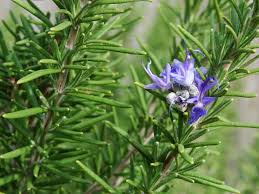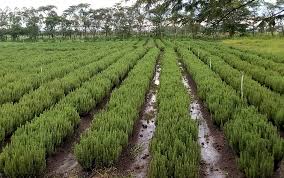![]()
If you’ve landed on this article page, you’re probably searching for a
good business idea—an idea that’s light on the pocket but heavy on
returns, promising both a fulfilling journey and potential profit.
|
Rosemary Farming in Nigeria: A Lucrative Agricultural Venture
Rosemary
(Rosmarinus officinalis) is an evergreen perennial herb native
to the Mediterranean region. Known for its distinctive aroma and
flavour, rosemary has been used for centuries in cooking,
traditional medicine, and aromatherapy. The plant belongs to the
mint family (Lamiaceae) and is characterised by its needle-like
leaves and small, pale blue or white flowers.
Rosemary farming has emerged as a promising and lucrative
agricultural venture in Nigeria, offering farmers and
entrepreneurs an opportunity to tap into a growing market for
this aromatic herb. As the demand for natural ingredients in
culinary, medicinal, and cosmetic applications continues to
rise, rosemary cultivation presents an attractive option for
those looking to diversify their agricultural pursuits or start
a new business in the sector.
In recent years, rosemary has gained popularity worldwide due to
its versatile applications and potential health benefits. This
increased demand has created opportunities for farmers in
various regions, including Nigeria, to cultivate and profit from
this valuable herb.
Land preparation and planting techniques
Proper land preparation is crucial for establishing a healthy
and productive rosemary crop. Follow these steps to prepare your
land and plant your rosemary:
Soil Testing:
Conduct a comprehensive soil test to determine pH levels and
nutrient content.
Adjust soil pH if necessary, using lime (to raise pH) or sulphur
(to lower pH).
Land Clearing:
Remove existing vegetation, rocks, and debris from the planting
area.
Level the land to ensure even water distribution and prevent
waterlogging.
Soil Tillage:
PloughPlough the land to a depth of 30–4030–40 cm to loosen the
soil and improve aeration.
Create raised beds or mounds if drainage is a concern.
Soil Amendment:
Incorporate organic matter (compost and well-rotted manure) to
improve soil structure and fertility.
Add any necessary nutrients based on the soil test results.
Planting Layout:
Design rows with proper spacing: 60–9060–90 cm between rows and
30-45 cm between plants.
Consider intercropping with compatible plants to maximise land
use and diversify income.
Propagation Methods: a) Seeds:
Sow seeds directly in the prepared soil or start in seedling
trays.
Plant seeds 0.5–10.5–1 cm deep and moisten the soil until
germination.
Expect germination in 14–2114–21 days.
b) Cuttings:
Take 10–1510–15cm of cuttings from healthy, mature plants.
Remove the lower leaves and dip the cut end in the rooting
hormone.
Plant cuttings in a well-draining medium and keep moist until
roots develop (4-6 weeks).
c) Seedlings:
If using pre-grown seedlings, transplant them to the prepared
field when they reach 10–1510–15 cm in height.
Water thoroughly after transplanting, and provide shade for a
few days if necessary.
Mulching:
Apply a layer of organic mulch (straw, wood chips, or dried
grass) around the plants.
Mulching helps retain moisture, suppress weeds, and regulate
soil temperature.
Initial Care:
Water the newly planted rosemary regularly to establish strong
root systems.
Monitor for pests and diseases, taking prompt action if any
issues arise.
By following these land preparation and planting techniques,
you’ll create an optimal environment for your rosemary plants to
thrive in Nigeria’s climate.
Irrigation and Water Management: Effective water management is
critical for successful rosemary cultivation in Nigeria,
especially in regions with irregular rainfall patterns. While
rosemary is relatively drought-tolerant once established,
consistent moisture is essential for optimal growth and yield.
Here are key considerations for irrigation and water management:
Water Requirements: Rosemary typically needs about 1-2 inches of
water per week during the growing season.
Adjust the watering frequency based on local climate, soil type,
and plant growth stage.
Irrigation Methods: a) Drip Irrigation:
A highly efficient system that delivers water directly to the
plant roots.
Reduces water waste and minimises leaf wetness, which can lead
to fungal diseases.
Ideal for large-scale rosemary production.
b) Sprinkler Systems: Can be used for smaller plantations or as
a supplementary method.
Ensure even water distribution and adjust spray patterns to
avoid overwetting foliage.
c) Manual watering: Suitable for small-scale operations or areas
with limited access to irrigation infrastructure.
Use watering cans or hoses with fine spray nozzles to avoid
damaging plants.
Watering Schedule: Water deeply but infrequently to encourage
deep root growth.
Early morning or late afternoon watering is preferable to reduce
evaporation losses.
Adjust the watering the watering frequency during rainy seasons
to prevent waterlogging.
Moisture Monitoring: Use soil moisture sensors or simple methods
like the finger test to assess soil moisture levels.
Maintain consistent moisture without oversaturating the soil.
Rainwater Harvesting: Implement rainwater collection systems to
supplement irrigation during dry periods.
Store harvested rainwater in tanks or reservoirs for use during
water-scarce times.
Mulching for Water Conservation: Apply organic mulch around
plants to retain soil moisture and reduce evaporation.
Replenish mulch regularly as it decomposes.
Drainage Management: Ensure proper field drainage to prevent
waterlogging, especially during heavy rains.
Create drainage channels or raised beds in areas prone to water
accumulation.
Water Quality: Test irrigation water for salinity and pH levels.
If you’re using borehole water, ensure it’s free from
contaminants that could affect plant health.
Drought Mitigation: Develop contingency plans for periods of
water scarcity.
Consider installing water-efficient irrigation systems and
implementing water-saving practices.
Record Keeping: Maintain detailed records of watering schedules,
rainfall, and plant responses.
Use this data to optimise water management strategies over time.
By implementing an effective irrigation and water management
plan, you can ensure that your rosemary plants receive the right
amount of water throughout their growth cycle, leading to
healthy plants and optimal yields.
Proper fertilisation is crucial for maintaining healthy rosemary
plants and achieving high yields. While rosemary is not a heavy
feeder compared to some crops, it still requires balanced
nutrition for optimal growth. Here’s a comprehensive guide to
fertilisation and nutrient management for rosemary farming in
Nigeria:
Soil Testing: Conduct regular soil tests (at least annually) to
determine nutrient levels and pH.
Use test results to tailor your fertilisation program and avoid
over- or under-fertilising.
Harvesting and post-harvest handling
Proper harvesting and post-harvest handling are crucial for
maintaining the quality and value of your rosemary crop. Timely
harvesting and appropriate handling techniques ensure that the
herb retains its flavour, aroma, and medicinal properties.
Here’s a detailed guide on harvesting and post-harvest handling
for rosemary farming in Nigeria:
Developing effective marketing and sales strategies is crucial
for the success of your rosemary farming venture in Nigeria. A
well-planned approach will help you identify and reach your
target markets, differentiate your product, and maximise
profitability.
By implementing a comprehensive marketing and sales strategy,
you can effectively position your rosemary products in the
market, build a loyal customer base, and maximise the
profitability of your farming venture. Remember to regularly
review and adjust your strategies based on market feedback and
changing consumer preferences.
|







